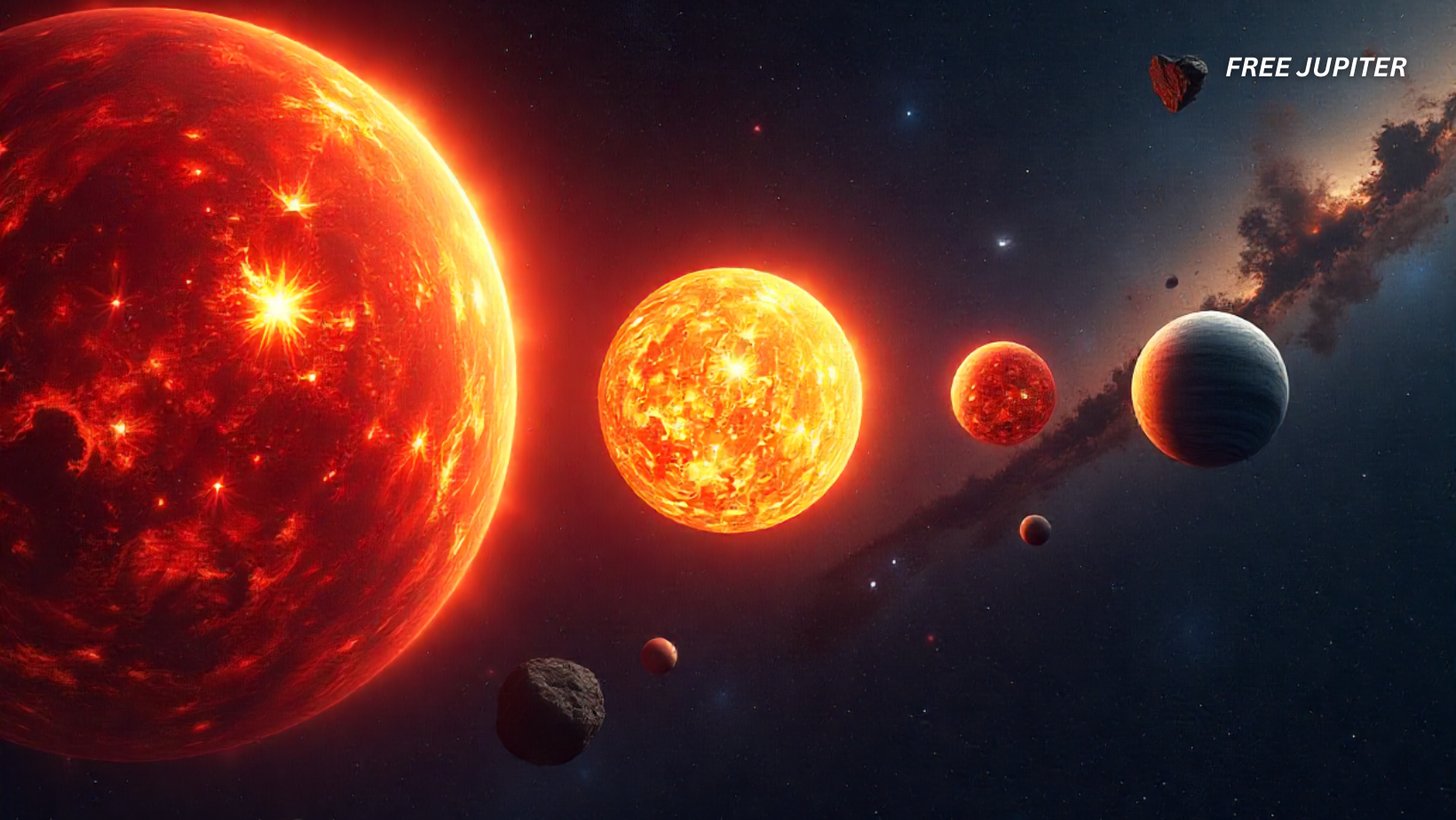Note: FreeJupiter.com shares general info for curious minds 🌟 Please fact-check all claims—and always check health matters with a professional 💙
The universe is full of surprises, but every now and then, astronomers stumble upon something that truly defies expectations. Recently, a team of researchers discovered a quadruple star system — a gravitationally bound arrangement of four objects, including two unusual brown dwarfs and two red dwarf stars. Located just 82 light-years away, this system isn’t the most complex one ever found, but it’s rare and scientifically valuable.
Why is this so exciting? Because brown dwarfs — often called “failed stars” — are some of the most elusive objects in the galaxy. They’re faint, cold, and hard to study, making every new discovery a big deal. And when two of them show up orbiting two other stars in a single system, astronomers know they’ve hit the cosmic jackpot.
This find could help scientists better understand how stars and planets form, what happens in the gray area between stars and planets, and why multi-star systems like this one manage to survive in the chaotic early stages of stellar evolution.
A Rare Find in Our Galactic Neighborhood
Astronomers have uncovered something extraordinary in the Milky Way — a quadruple star system just 82 light-years away. What makes this setup fascinating is its unusual arrangement: two brown dwarfs orbiting each other while circling two other stars, which also orbit each other. Essentially, it’s a pair of pairs locked in a gravitational dance.
This isn’t just an astronomical curiosity; it’s a breakthrough that could help scientists understand how stars and star-like objects form. The research, published in the Monthly Notices of the Royal Astronomical Society, offers new clues about the universe’s most mysterious objects.
Read more: New Discovery Suggests a Comet Explosion Altered The Earth 12,800 Years Ago
Brown Dwarfs: The Galaxy’s “Failed Stars”
The story begins with an ambitious hunt for brown dwarfs — objects that occupy a strange middle ground between stars and planets. They’re too big to be planets but too small to shine like stars. Because they don’t sustain hydrogen fusion, they’re often nicknamed “failed stars.”
Brown dwarfs are cold, faint, and notoriously difficult to spot. They glow mainly in infrared light, which is invisible to the human eye, requiring astronomers to use specialized instruments to detect them.
The Plot Twist: From One Pair to Two
Initially, scientists thought they had found something simple: a brown dwarf orbiting a single bright star. But the closer they looked, the more surprises appeared.
The brown dwarf? Actually two brown dwarfs orbiting each other.
The bright star? Turns out, it was two red dwarfs in a tight orbit.
In short, what appeared to be a binary system turned out to be a quadruple system — a rare and scientifically exciting configuration. As astrophysicist Adam Burgasser put it:
“I like to call this a double-double.”
A cosmic double-double — and not the coffee kind.
Why This Discovery Is a Big Deal
Quadruple star systems aren’t completely unheard of, but they’re rare enough to make astronomers pay attention — especially when they involve brown dwarfs. Such systems act as cosmic benchmarks, allowing scientists to measure properties like mass, age, and temperature more accurately.
Normally, brown dwarfs are hard to study because they’re faint. But when paired with brighter stars, astronomers can infer key details by analyzing the stars’ characteristics. With two stars and two brown dwarfs, this system is a jackpot:
“It becomes kind of like a super benchmark,” Burgasser said.
Brown Dwarfs: Not Quite Stars, Not Quite Planets
To understand why astronomers are so excited, let’s break down what brown dwarfs actually are:
- Too Small to Shine: Unlike true stars, they lack the mass needed for hydrogen fusion.
- Too Big to Be Planets: They’re similar in size to Jupiter but can be dozens of times heavier.
- Gas Giant Cousins: Their atmospheres resemble those of gas giants like Jupiter and Saturn, often containing methane.
Scientists believe there are billions of brown dwarfs scattered across the galaxy, yet only a few have been found orbiting brighter stars. This makes the new discovery even more significant.
Read more: China Found Graphene in Moon Dust That Shouldn’t Exist—Here’s Why It’s a Huge Deal
How Did Astronomers Spot It?
The hunt for this quadruple system involved some clever detective work. Researchers relied on data from two major space missions:
- NASA’s WISE (Wide-field Infrared Survey Explorer): Excellent for detecting cool, dim objects like brown dwarfs.
- ESA’s Gaia mission: Famous for its precise star mapping.
By combining these datasets, the team identified a system about 82 light-years away. Initial analysis suggested a single brown dwarf and a star orbiting each other at a massive distance — 1,600 times the Earth-Sun gap.
But with help from the Southern Astrophysical Research Telescope in Chile, astronomers uncovered the truth: both the star and the brown dwarf were actually pairs. A simple binary system had turned into a quadruple system.
What We Know About This System
Here’s what scientists have learned so far:
- Brighter Pair: Two red dwarfs, each about 17% the mass of our Sun. Combined, they are 100,000 times fainter than the North Star in visible light.
- Dimmer Pair: Two brown dwarfs about the size of Jupiter, with methane in their atmospheres. They emit very little visible light.
- Distance: Roughly 82 light-years from Earth — relatively close in cosmic terms.
- Orbital Scale: The two pairs orbit each other at a huge distance, helping them remain stable for billions of years.
The Future: Sharper Views with Next-Gen Telescopes
The next step? Detailed observations using instruments like NASA’s James Webb Space Telescope (JWST). JWST’s infrared capabilities can provide clearer images and precise measurements of the brown dwarfs’ masses and temperatures.
Other upcoming projects — such as Euclid and the Vera C. Rubin Observatory — will expand our ability to find faint, hidden objects like these. There’s a good chance more quadruple systems are out there waiting to be discovered.
Why Should We Care About Four Stars?
It’s a fair question: why does a quadruple star system matter to us? Beyond its rarity, discoveries like this help answer some of the biggest questions in astronomy:
- How do stars and planets form?
- What happens at the threshold between stars and planets?
- Could such systems have planets of their own?
Each new system like this acts as a cosmic time capsule, giving scientists clues about the messy, chaotic process of star formation and the dynamics of multi-star systems.
Read more: Scientists Claim a Real-Life Warp Drive Is Now Possible — No, This Isn’t Sci-Fi
The Cosmic Takeaway
Quadruple star systems may sound like science fiction, but they’re real — and this one is close enough for detailed study. With its two stars and two brown dwarfs bound together in a slow gravitational waltz, this “double-double” isn’t just an oddity. It’s a window into the universe’s complexity.
As Burgasser said:
“These are the kinds of clues that we’re seeing — the output of multiple star formation. But we’re still interested in what got it there in the first place.”
And that’s what makes astronomy so captivating: every new discovery is just the beginning of another question.
Image: Freepik.










